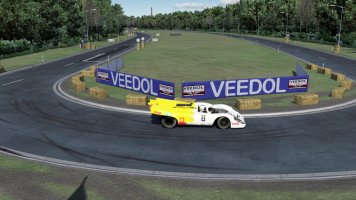Every time DTM visits the Norisring like it does this weekend, the series is in for something special: Street circuits like the one around the Zeppelintribüne in Nuremberg used to be more prevalent in Germany until the 1990s, but today, the Norisring is the only one left. It is a bit crazy by today’s standards, but have you heard of the layout used until 1971?
The Norisring street circuit follows a relatively simple layout these days: Drivers head down the start/finish straight in front of the enormous grandstand, brake for Grundig-Kehre in a slight right turn, make their way to the left-right of Schöller-S around the grandstand and brake for Dutzendteich-Kehre in a slight right before navigation the final full-throttle left for the start of another lap.
While the 1949 to 1951 layout was all kinds of weird in its own right, using two underpasses and bypassing the Dutzendteich-Kehre, it was nothing compared to the version that was used from 1952 to 1957 and 1961 to 1971: Instead of turning left into today’s Grundig-Kehre, drivers would continue to go full-throttle down the slight right of Beuthener Strasse called the “hose” by race-goers of the time, until they reached the hairpin way further down the road than today and making their way back towards the chicane.
This would not be too dangerous in somewhat slower cars, but the late 1960s saw the introduction of high-powered sports cars like the Porsche 917 or the Ferrari 512 that would reach ludicrous top speeds at Le Mans – at the Norisring, these cars would do 300kp/h before braking for the hairpin! There was barely anything in place to separate the two curved straights before and after the hairpin either, so cars could potentially end up in oncoming traffic – or the trees and lamp posts lining the track. Video from the 1970 200 Meilen of Nürnberg suggests that there was at least a single armco barrier for part of the run to the hairpin.
All of this madness can be experienced in Assetto Corsa: Sergio Loro, creator of F3 Classic Tracks, has built the two vintage versions mentioned for the sim. Both are available for free, so I strongly recommend picking them up if you have not already – go and try to race a Porsche 917 around these narrow, fast streets to gain an appreciation for what the drivers of the day were doing! A modern version of the track can also be found for Assetto Corsa here at RaceDepartment.
Sadly, the inherent danger of the track led to the loss of Formula One and sportscar ace Pedro Rodriguez in an Interserie race: The Mexican crashed his Ferrari 512M under braking before the chicane, hitting a bridge wall. His car burst into flames, Rodriguez had no chance. The layout with the long “hose” has been abandoned since, with the Grundig-Kehre being moved to its current position as a result of the crash.
The Norisring street circuit follows a relatively simple layout these days: Drivers head down the start/finish straight in front of the enormous grandstand, brake for Grundig-Kehre in a slight right turn, make their way to the left-right of Schöller-S around the grandstand and brake for Dutzendteich-Kehre in a slight right before navigation the final full-throttle left for the start of another lap.
While the 1949 to 1951 layout was all kinds of weird in its own right, using two underpasses and bypassing the Dutzendteich-Kehre, it was nothing compared to the version that was used from 1952 to 1957 and 1961 to 1971: Instead of turning left into today’s Grundig-Kehre, drivers would continue to go full-throttle down the slight right of Beuthener Strasse called the “hose” by race-goers of the time, until they reached the hairpin way further down the road than today and making their way back towards the chicane.
This would not be too dangerous in somewhat slower cars, but the late 1960s saw the introduction of high-powered sports cars like the Porsche 917 or the Ferrari 512 that would reach ludicrous top speeds at Le Mans – at the Norisring, these cars would do 300kp/h before braking for the hairpin! There was barely anything in place to separate the two curved straights before and after the hairpin either, so cars could potentially end up in oncoming traffic – or the trees and lamp posts lining the track. Video from the 1970 200 Meilen of Nürnberg suggests that there was at least a single armco barrier for part of the run to the hairpin.
All of this madness can be experienced in Assetto Corsa: Sergio Loro, creator of F3 Classic Tracks, has built the two vintage versions mentioned for the sim. Both are available for free, so I strongly recommend picking them up if you have not already – go and try to race a Porsche 917 around these narrow, fast streets to gain an appreciation for what the drivers of the day were doing! A modern version of the track can also be found for Assetto Corsa here at RaceDepartment.
Sadly, the inherent danger of the track led to the loss of Formula One and sportscar ace Pedro Rodriguez in an Interserie race: The Mexican crashed his Ferrari 512M under braking before the chicane, hitting a bridge wall. His car burst into flames, Rodriguez had no chance. The layout with the long “hose” has been abandoned since, with the Grundig-Kehre being moved to its current position as a result of the crash.

